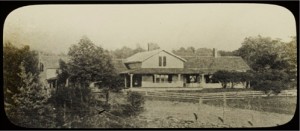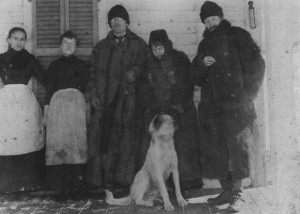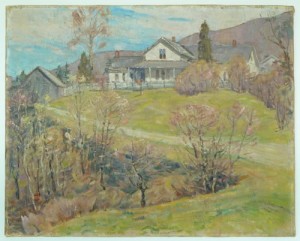On this page you will find information about Robert Louis Stevenson’s travels to New York state. In particular, you will find details of his visits to New York City and Saranac Lake.
New York City
“As we drew near to New York I was at first amused and then somewhat staggered, by the cautions and the grisly tales that went the round. You would have thought we were to land upon a cannibal island. You must speak to no one in the streets, as they would not leave you till you were rocked and beaten.”

“You must enter a hotel with military precautions; for the least you had to apprehend was to awake next morning without money or baggage, or necessary raiment, a lone forked radish in a bed; and if the worst befell, you would instantly and mysteriously disappear from the ranks of mankind.”
(The Amateur Emigrant, The Works of Robert Louis Stevenson, Swanston edn, vol ii [London: Chatto and Windus, 1911], p. 77)
Stevenson made two journeys to the United States – the first to cement his relationship with Fanny Van de Grift Osbourne, and the second to recover his health (see the section on this page devoted to Saranac Lake). After the second visit, RLS and his family went on to travel the South Seas and settle in Samoa – they were never to return to the United States or to Europe.
In both of Stevenson’s journeys through the USA, he stayed in New York City – New York, like London, was often a place that RLS stopped on the way to somewhere else. Nevertheless, it still held the feeling of adventure that RLS found so fascinating about the US: “A few wild story-books which delighted his childhood form the imaginative basis of his picture of America. In course of time , there is added to this a great crowd of stimulating details – vast cities that grow up as by enchantment [. . .]. Here I was at last in America, and was soon out upon New York streets, spying for things foreign” (RLS, The Amateur Emigrant, The Works of Robert Louis Stevenson, Swanston edn, vol ii [London: Chatto and Windus, 1911], p. 81).
New York City and the First Trip to the USA
On 7 August 1879 RLS boarded the Devonia at Greenock. The ship was bound for New York and he himself was bound for California to see Fanny Van de Grift Osbourne, the woman who would soon be his wife. You can read about his journey on board the Devonia and his arrival in New York in The Amateur Emigrant (1895).
Stevenson arrived in New York City on 17 August 1879. He stayed in a boarding house at 10 West Street:
“Reunion House, No. 10, West Street, one minute’s walk from Castle Garden; convenient to Castle Garden, the Steamboat Landings, California Steamers and Liverpool Ships; Board and Lodging per day 1 dollar, single meals 25 cents, lodging per night 25 cents, private rooms for families; no charge for storage or baggage; satisfaction guaranteed to all persons; Michael Mitchell, proprietor” (The Amateur Emigrant, The Works of Robert Louis Stevenson, Swanston edn, vol ii [London: Chatto and Windus, 1911], p. 79).
Here, he ran errands in preparation for his long journey the following day: on the evening of 18 August he left New York for New Jersey where he began his train journey to California. You can read about this journey in the “Across the Plains” page of the Footsteps section by clicking here.
After their marriage and honeymoon (which you can read about in the California page in the Footsteps section by clicking here) RLS and Fanny decided to journey to the UK – they were bound for New York again. Stevenson, his wife and stepson Lloyd took a train out of San Francisco on 29 July 1880. They arrived in New York on 6 August 1880. On the following day they sailed from New York in the City of Chester to Liverpool.
New York City and the Second Trip to the USA
On 22 August 1887, RLS, his mother, his wife, Lloyd and the maid Valentine Roch, boarded the Ludgate Hill at the Albert Docks. They were bound for New York (via Le Havre). Unfortunately, the Ludgate Hill turned out to be a cattle-boat, but RLS loved the journey and the sense of adventure. The ship arrived in New York on 7 September 1887.
The party were met in New York by RLS’s friend Will H. Low (who RLS would spend time with after his visit to Newport) and Edward L. Burlingame, the editor of Scribner’s Magazine. They were also met by a crowd of reporters: RLS arrived as a literary celebrity, Jekyll and Hyde (1886) having met with great popularity in the States. RLS wrote: “My reception here was idiotic to the last degree; if Jesus Christ came, they would make less fuss” (Letter from RLS to Sidney Colvin, c. 18 September 1887, from The Letters of Robert Louis Stevenson, ed. by Bradford A. Booth and Ernest Mehew, vol vi [New Haven: Yale University Press, 1995], p. 5).
On the 7th, the party stayed in Victoria Hotel (as the philanthropist Charles Fairfield’s guest). The following day, RLS was invited to Newport, Rhode Island, to visit Fairfield (for more information see the Rhode Island page in the Footsteps section here). He stayed from 8 -19 September, returning to New York on the 19th.
On his return he stayed at Hotel St Stephen, East Eleventh Street until 30 September. It was here, on 24 September that RLS would pose for the sculptor Augustus Saint-Gaudens (1848-1907). Saint-Gaudens made the medallion of RLS that would later be reproduced for the RLS memorial in St Giles Cathedral, Edinburgh. RLS also dealt with business matters in New York: he confirmed publishing deals with Scribner’s Magazine and the publisher Sam McClure.
On the 30th, RLS took a train to Saranac Lake (where he would winter for his health – see below) via Albany and Plattsburgh. On 13 April RLS left Saranac Lake for New York, travelling via Albany and Plattsburgh. He arrived in New York on 16 April 1888, staying at Hotel St Stephen. On 2 May he moved to Manasquan, New Jersey (for more information see the page devoted to New Jersey in the Footsteps section by clicking here).
Stevenson returned to New York from Manasquan on 28 May 1888. Once more, he stayed at Hotel St Stephen. The Stevensons were now getting ready for their trip to the South Seas. Although they (RLS, his mother, Valentine Roch the maid and Lloyd – Fanny was already in California) originally planned to leave for San Francisco on 31 May, RLS fell ill. They delayed their journey until 2 June, when they took a train to California (via Chicago and Salt Lake City). Fanny joined the party at Sacramento, and they reached San Francisco on 7 June.
Saranac Lake, Adirondack Mountains
“I am at Saranac Lake in the Adirondacks, I suppose for the winter; it seems a first rate place; we have a house in the eye of many winds, with a view of a piece of running water – Highland, all but the dear hue of peat – and of many hills – Highland also, but for the lack of heather. Soon the snow will close on us; we are here some twenty miles – twenty-seven they say, but this I profoundly disbelieve – in the woods; communication by letter is slow and (let me be consistent) aleatory; by telegram, is as near as may be impossible”
(Letter from RLS to Edmund Gosse, 8 October 1887, from The Letters of Robert Louis Stevenson, ed. by Bradford A. Booth and Ernest Mehew, vol vi [New Haven: Yale University Press, 1995], pp. 24-25)

On 30 September 1887, RLS, his wife, his mother, Lloyd and the maid Valentine Roch took a train to Saranac lake (via Albany and Plattsburgh). They arrived on 3 October. RLS would stay in Baker Cottage, Saranac Lake until 13 April 1888.
Fanny, Lloyd and RLS’s mother would often go elsewhere during this winter stay in Saranac (elsewhere in New York or Montreal for example, and later Fanny took a trip to California). Fanny especially found that the cold weather did not suit her. RLS and his mother, however, seemed to really enjoy the freezing conditions. Stevenson wrote: “you should also see our back log when the thermometer goes (as it does go) away – away below zero, till it can be seen no more by the eye of man – not the thermometer, which is still perfectly visible, but the mercury, which curls up into the bulb like a hibernating bear”
(Letter from RLS to Adelaide Boodle, c. 10 December 1887, The Letters of Robert Louis Stevenson, ed. by Bradford A. Booth and Ernest Mehew, vol vi [New Haven: Yale University Press, 1995], p. 77).
On the 13th they left Saranac Lake for New York, travelling via Albany and Plattsburgh. RLS and his mother stayed overnight in Albany at Delaware House (c. 15 September). They arrived in New York on 16 April 1888, where they stayed at Hotel St Stephen.
Below you will find information about RLS and his health in the Adirondacks, his writing during his stay at Saranac Lake, his quarrel with W.E. Henley, and information about the museum at Saranac Lake.
The Health Benefits of the Adirondacks
In Bournemouth, Stevenson’s doctors had initially advised that RLS spend a year in Colorado – the mountain air was thought to be curative. When the Stevenson party arrived in New York in September 1887, however, the plans changed and Colorado seemed an uninviting prospect. They were advised that the Adirondacks would be beneficial to Stevenson’s health. As a result, the family decided to settle at Baker Cottage in Saranac Lake for the winter.
At Saranac, RLS took advice and treatment from Dr. Edward Livingstone Trudeau (1848-1915). A tuberculosis sufferer, Trudeau had founded the Adirondack Cottage Sanitarium at Saranac Lake in 1884. This was the first open air treatment centre for tuberculosis. Trudeau also opened the Saranac Laboratory for the Study of Tuberculosis, the first American laboratory to research the disease.

The lab was renamed the Trudeau Institute and now stands in Saranac Lake Village. The original lab is now Historic Saranac Lake, a non-profit organization dedicated to the preservation of the history and architecture of Saranac Lake.
RLS wrote a letter to The Evening Post endorsing Trudeau’s treatment (it was published in the paper as “Mr R. L. Stevenson on the Adirondack Cure” on 5 March 1888):
“I was struck to observe the other day, in more papers than one, great praise of the new system of treatment in phthisis, and great lamentation that no establishment on this principle should yet exist in the United States. These complaints read to me very strangely in this place, where I am almost within sight of the ‘Adirondack Cottages for the Treatment of Pulmonary Disease’. In that establishment patients enjoy the advantages of this harsh but pure and antiseptic air, of pleasant lodging in fine scenery, of a generous diet, continual open air and carriage exercise [. . . ]. It is plain these cottages are run at a loss, and the deficiency must be supplied among the rich and generous. And how shall this continue to be accomplished if even the newspapers are ignorant of their existence?” (Letter from RLS to the Editor of The Evening Post, New York, 1 March 1888, The Letters of Robert Louis Stevenson, ed. by Bradford A. Booth and Ernest Mehew [New Haven: Yale University Press, 1995], p. 122).
RLS’s own health did seem to benefit from the freezing conditions at Saranac. He wrote to Sidney Colvin: “I could aspire to be elsewhere; but yet I do not catch cold, and yet, when I come in, I eat. So that hitherto, Saranac, if not deliriously delectable, has not been a failure; nay, from the mere point of view of the wicked body, it has proved a success” (c. 20 November 1878, The Letters of Robert Louis Stevenson, ed. by Bradford A. Booth and Ernest Mehew, vol vi [New Haven: Yale University Press, 1995], p. 59).
The Author at Saranac Lake
RLS was extremely productive at Saranac Lake. He worked on “A Chapter on Dreams”, “The Lantern Bearers”, “Beggars” and “Pulvis et Umbra”. These 1888 essays were all later published in Across the Plains (1892). He also worked on “Gentlemen”, “Some Gentlemen in Fiction” and “Popular Authors” (all 1888).
In December he began working on The Master of Ballantrae (1889). In “The Genesis of The Master of Ballantrae” (1896) RLS wrote about how he was inspired to write the novel:
“I was walking one night in the verandah of a small house in which I lived, outside the hamlet of Saranac. It was winter; the night was very dark; the air was extraordinary clear and cold, and sweet with the purity of forests. From a good way below, the river was to be heard contending with ice and boulders: a few lights appeared, scattered unevenly among the darkness, but so far away as not to lessen the sense of isolation. For the making of the story here were fine conditions. [. . . ] On such a fine frosty night, with no wind and the thermometer below zero, the brain works with much vivacity; and the next moment I had seen the circumstance transplanted from India and the tropics to the Adirondack wilderness and the stringent cold of the Canadian border” (“The Genesis of The Master of Ballantrae in Essays in the Art of Writing [London: Chatto and Windus, 1905], pp. 135-37).
Indeed, parts of the story do take place in the wilds of New York state – it is evident that Stevenson found Saranac conducive to both his health and his writing. Lloyd also fell to writing at Saranac. He began working on The Wrong Box (1889 – at different points in the writing process it was also called A Game of Bluff and The Finsbury Tontine). Stevenson began working with Lloyd on the project in March 1888. This was the beginning of a literary partnership that , as well as The Wrong Box, would also see publication of The Wrecker (1892) and The Ebb-Tide (1894).
Quarrel with Henley
While RLS and Lloyd were both busy writing, it was actually Fanny’s writing that was to cause controversy for Stevenson at Saranac: it was when Fanny published the short story “The Nixie” (published in the March 1888 edition of Scribner’s Magazine) that RLS and W.E. Henley were to quarrel bitterly. Their friendship would never fully recover.
In March 1888 Henley accused Fanny of plagiarism. He argued that “The Nixie” had actually been taken from one of Katharine De Mattos’s own stories. While in England Fanny and Katharine had discussed the story. Fanny suggested that instead of it being about an escapee from a lunatic asylum, that it should be about a water sprite – a nixie. Fanny understood that if Katharine could not publish her version, Fanny would publish her own. Afterwards, Katharine said that she had not expected Fanny to go ahead with the publication, and was hurt by what had happened. Bob Stevenson took his sister’s and Henley’s view of the event, while RLS took Fanny’s side. The quarrel damaged his relationship not only with Henley, but also with both of his cousins.
For more information about the quarrel, see also the entry on W.E. Henley on the Friends page.
Museum at Saranac Lake
If you would like to follow in RLS’s footsteps in Saranac, you can visit the cottage where the family stayed. Baker Cottage is now an RLS museum.
Images 1 & 2 courtesy of the Writers’ Museum, Edinburgh
Image 3: ‘RLS Cottage Saranac Lake’ by Horace Brown (1876–1949) courtesy of Don Vogt
